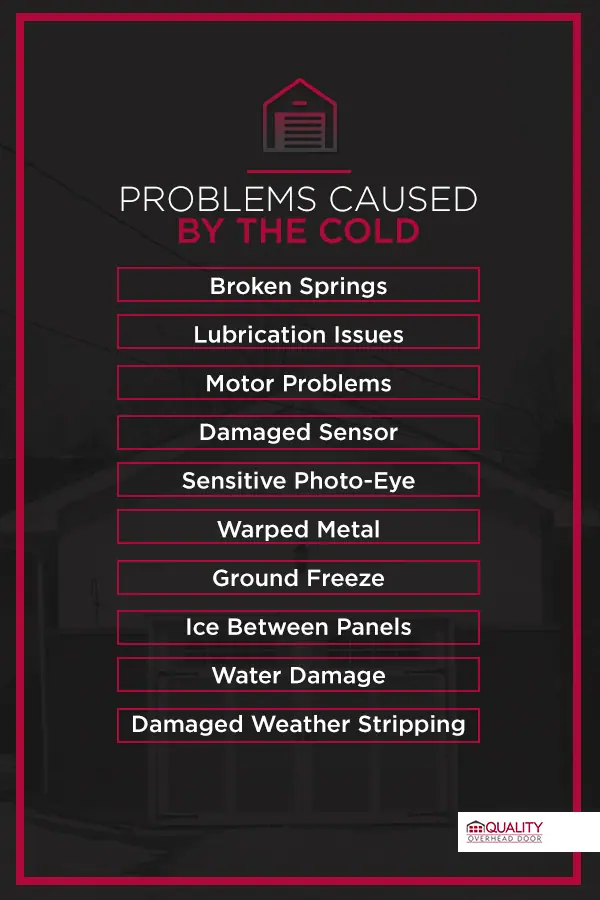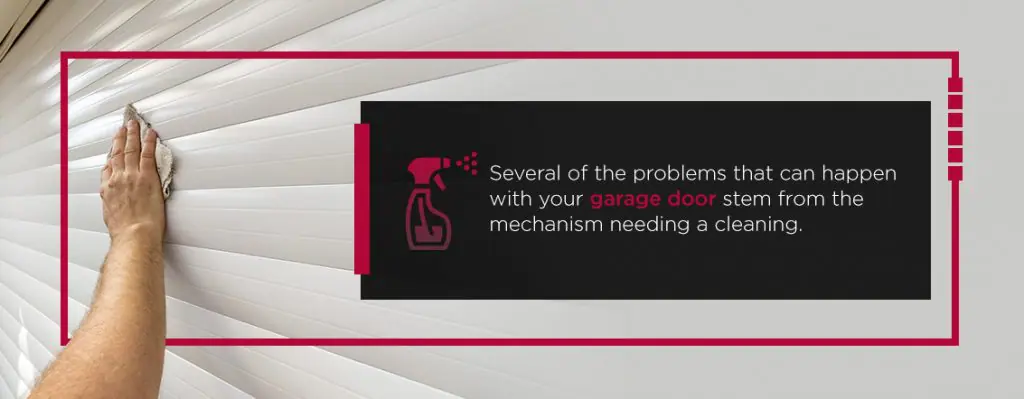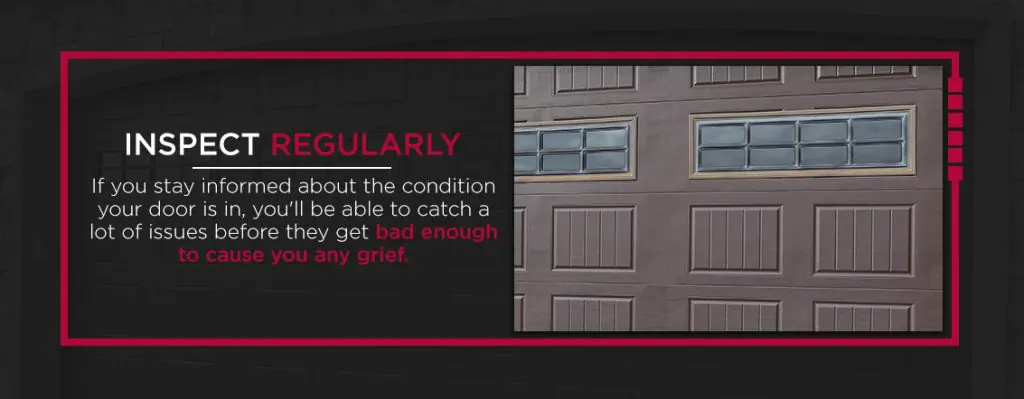When the weather starts to get colder, you’re probably glad to have a garage to keep your car in. In addition to the colder temperatures, winter brings snow and sleet, all of which are capable of causing problems for your vehicle. It’s good to be able to keep it secure behind a garage door.
But what happens when your garage door stops working properly? The same way the cold weather can negatively impact your car, it can also affect your garage door. Fortunately, there are ways to handle the various problems that can arise. But first, it’s best to understand what those problems might be.
Problems Caused by the Cold
Plenty of things can cause garage door problems, but if it happens in winter, there’s a good chance it has to do with the cold. But how does cold weather affect garage door openers? Well, there’s no one issue that’s necessarily to blame. Cold weather can lead to a few different garage door issues, so you may have to do a bit of investigating to figure out which one it is.

A great initial way of diagnosing the problem is to apply a manual lift test, where you disconnect the garage door from the lift mechanism and pull it up yourself. To do any of this effectively, it’s good to be aware of the potential issues so you know what to look for. Here are some of the most common reasons for your garage door not opening in winter:
1. Broken Springs
Cold weather can negatively affect garage doors in several ways, and broken springs are just one of the main ways this happens. Wear and tear is the main culprit here — springs usually last around 10,000 cycles, and it’s easy to forget to perform regular maintenance checks on the springs during the hectic winter months.
You can check the springs with the manual lift test. Lift the door to roughly the halfway point, then let go of it. If it remains where it is, the springs aren’t the problem. If it starts to sink, the springs need to be replaced.
Another way to guard against the effects of broken springs is to install a safety cable. If you take care of that installation before any springs break, you won’t have to worry so much. The safety cable exerts enough force to act as a door weight counter. If your spring does break, call an expert right away, even if you do have a safety cable installed. Garage doors are dangerous without proper spring function.
2. Lubrication Issues
Most garage door openers need to stay lubricated year-round to keep the moving parts running smoothly. In the winter, it’s not uncommon for these products to change consistency from the cold temperatures. In general, this is bad for the garage door opener and every moving part that requires lubrication.
You can check for this issue by trying to lift the garage door manually. If it gets stuck in different spots on the way up, it most likely has a lubrication problem. The problem could stem from the lubrication having thickened or from it being spread around inconsistently. One way to counteract this occurrence is to use lubrication with a viscosity rating appropriate for the lowest temperature you tend to have in your area.
3. Motor Problems
Sometimes, the problem isn’t with the door itself but with some element of the mechanism that lifts it. If you apply the manual lift test and the door goes up and down with no issue, you know that’s likely the case. In particular, it may be the motor that powers that mechanism.
If the motor is damaged, don’t try to fix it yourself — you could end up making the problem worse. There could be different things wrong with it, and motors are relatively complex for anyone not well-experienced with them. For this issue, you’ll have to call a professional to repair it. Note any unusual sounds you hear — like grinding, popping or squeaking — to help better diagnose the problem.
4. Damaged Sensor
If the door passes the manual lift test, the motor might be the problem, but it’s not the only possibility. The remote sensor may also be the cause of the issue. If the remote you use to open the door is damaged, it might not be properly sending signals to the mechanism. You’ll still probably want to call a professional to deal with it, but it will be easier to handle than a damaged motor.
5. Sensitive Photo-Eye
Another major possibility is that you have an issue with your photo-eye, the sensor at the base of the garage opening that detects objects in the door’s path. If it detects any, it prevents the door from closing so nothing gets damaged.
The problem is that photo-eyes rely on a certain level of sensitivity, which can cause them to interpret some things as obstacles that really aren’t. For example, thickened lubrication can count as an obstacle. It’s possible — especially when you have the sensitivity setting on “light” — for the motor to sense the new consistency of the lubricant and think the door is hitting something, which causes the door’s movement to halt.
If the photo-eye gets fogged up by the cold weather, it can distort its view and cause it to react to the condensation as an obstacle. In each of these cases, the sensor will tell the door not to move when you push the remote. Treating the lubrication is one way of helping with this. Cleaning the lens on the photo-eye is another — you’ll find these sensors in small boxes near the ground.
6. Warped Metal
If you have trouble lifting the door manually and the lubrication seems fine, the metal parts themselves may be the source of the problem. Metal contracts slightly in cold temperatures, which means winter weather causes the metal parts in the lift mechanism to grow tighter together and grind together.
In some cases, this creates enough resistance between connecting parts that they aren’t able to move, which leads to your door being stuck. Lubricant can fix this issue to some extent by letting the parts slide past one another more easily, but if the problem persists, you may have to call a professional.
7. Ground Freeze
This may seem like an obvious possibility, but it can be one of the most annoying cold weather effects on your garage door. If water pools at the bottom of the door, it can seal and freeze the door shut, which doesn’t leave many good or fast options for a solution. Here are some ways you can deal with this situation:
- Release cord: Manually open the door using the emergency release cord. Know that this option doesn’t always work, depending on the severity of the freeze.
- Scraping: Scrape and chip at the ice with a scraper or other tool.
- Heat gun: Melt the ice with a heat gun, but be careful not to apply too much heat to metal doors all at once.
- Hot water: Dump hot water along the base of the door for a quick fix, but be aware that this can potentially create a more hazardous icy area if it refreezes.
- Natural melting: Leave the door open once you have it open and wait for the ice to melt if the conditions are right.
Any method can take a lot of time and energy, and there’s no guarantee it will work. The best way to handle this issue is to avoid it altogether by sweeping puddles and snow away from the base of your door and inspecting for gaps or damage in the sealant and weatherstripping after winter storms.
8. Ice Between Panels
Most garage doors are composed of multiple panels that allow the door to bend and fold as it moves upward. Unfortunately, the connection points between these panels leave room for moisture to seep in and freeze. Once the panels become frozen together, they can’t fold, which prevents the door from opening.
To address this problem, you can apply some of the same methods listed for dealing with ground freeze — scraping, using a heat gun, pouring hot water on it or simply waiting for it to melt naturally. Be sure not to damage your door in the process, though. If your door is made of wood, for instance, a heat gun probably isn’t the best solution.
9. Water Damage
Particularly with wooden garage doors, the precipitation of winter can cause the door and its frame to swell. Snow from the roof can melt and run down into the entrance, where it can seep into the wood. In the worst instances, this leads to the space between the door and frame closing, causing them to rub against one another. The door can even get stuck where it is, which will keep it from opening when you need to go in or out.
You can deal with this issue by keeping your rain gutters clear so water runoff doesn’t splash onto the door and cause or add to swelling. Mop and dry any standing water that collects near the base of the garage door.
10. Damaged Weather Stripping
All of the issues so far have dealt with situations where the garage door doesn’t open in winter. But what if the door opens fine? What if the lubricant is in good shape, there’s no water damage, and the remote is operating without any issue? Does that mean the cold weather hasn’t hurt your garage door?
Not necessarily. Even if the door opens and closes without incident, it might still not be doing its job properly. The whole point of the garage door is to keep you and your car safe from the elements, and it does this with the aid of weather stripping around the edge of the entrance.
When this weather stripping becomes damaged, however — as cold weather and precipitation can lead to — it stops being able to guard against the outside temperatures and water that seek to get inside, negating the whole purpose of the garage door. Make sure you check your weather stripping to maintain its condition and replace it as needed.
How to Seal a Garage Door for Winter
Sealing your garage door promotes energy efficiency while minimizing drafts and temperature fluctuations. It also reduces the risk of pests or rainwater filtering in through unchecked gaps. Follow these steps before winter comes:
- Measure the door: Measure your door so you know how much weatherstripping you’ll need. Note the dimensions around the sides and across the top and bottom. Choose rubber or vinyl weatherstripping specifically made for garage doors — it should come in large rolls with adhesive material on the back.
- Prepare the area: Start by cleaning your garage door — make sure the cleaning agent is compatible with the garage door material. Carefully pull away any worn or broken weatherstripping. You’ll know weatherstripping needs to be replaced if you can still feel significant drafts and airflow around the area or if water is seeping in. You can also identify weak spots by noting where the sunlight filters through during the day.
- Seal cracks and gaps: Inspect the garage door for any gaps in the existing sealant and stripping. Fill any cracks or holes in the door with caulking if necessary.
- Add weatherstripping: You’ll need to cut it to fit each area. Depending on the type of stripping and application site, you might need to install it with galvanized fasteners. Other options include rubber sweeps and bottom seals. You’ll apply weather stripping to the door-side flange and around the edges of or between each panel, if applicable.
- Install stop molding: Vinyl stop molding is a versatile option that can help offset worn or damaged doors. You’ll cut it to size yourself and install it with galvanized fasteners parallel to the door’s face, moving the molding closer to the door to compress the weatherstripping.
- Reinforce if necessary: Some garages will benefit from door reinforcement, insulation or both. You can find insulation kits for small jobs or contact a professional for a full-scale installation. One reinforcement method to consider is a threshold seal, which attaches to the garage floor and works with or without a door seal. They bridge gaps between the ground level and garage door placement and help prevent water, snow and ice from flowing in or out.
Check weatherstripping and sealants often, especially after severe weather and periodically before and during cold or wet seasons.
Other Preventive Measures to Protect Your Garage Door
It’s great when you’re able to find ways of handling garage door problems in winter, but what’s even better is when you’re able to prevent those problems in the first place. To keep yourself from having to fix your garage door every year when winter rolls around, consider taking these steps to adjust your garage door for cold weather:
1. Brush and Wipe Clean
Several of the problems that can happen with your garage door stem from the mechanism needing a cleaning. Residue on the photo-eye lens can cause it to overreact to things, and gunky lubrication can cause trouble for the moving parts. Dirt and dust in the mechanism can only make those issues worse.
By periodically brushing off and wiping down the various parts of the garage door, you can do a lot to prevent excessive buildup from occurring. Make sure the photo-eye is wiped clean with a microfiber cloth every so often, and clean off any metal parts that have grown particularly dirty with a door-safe cleaning agent.
2. Use a Solvent
In addition to cleaning, you can minimize dirt buildup by regularly using a spray solvent. The solvent will dissolve any gunk that might start to develop on the mechanism, minimizing how much cleanup you even have to concern yourself with in the first place. Simply spray the solvent onto all the parts you need to clean the most often, and let it do the work. Be sure to follow all instructions on the label, including any protective measures — such as gloves, goggles or ventilation — to stay safe.
3. Apply Lubricant
Lubricant can sometimes change consistency and become gunky in cold weather, but that doesn’t mean you don’t want any there. The purpose of a lubricant is to make the metal parts slide across one another with greater ease, which helps the mechanism run and counteracts problems like metal warping.
Due to this fact, you’ll want to apply new lubricant to the mechanism every so often. Be sure to use a lubricant rated for the lowest temperature you tend to have in your area, as this will help it withstand the effects of the cold.
4. Inspect Regularly
One of the best preparations for possible garage door issues is to simply keep yourself updated on the state of the door — check the lubricant, the remote and the weather stripping. Look for water damage and dirty metal parts. If you stay informed about the condition your door is in, you’ll be able to catch a lot of issues before they get bad enough to cause you any grief. Contact a professional garage repair service if you find anything amiss — even the smallest issues can grow into more costly ones.
5. Check Remote Batteries
If your garage door stops working one day in winter, there’s a final precautionary measure you can take. Before you start scouring the whole mechanism in search of something that’s been damaged by the cold, check your remote. The problem could be something as simple as a dead battery.
Try replacing all the batteries in the remote and see if it’s able to open the door. If so, your problem’s fixed — nothing to worry about! If not, that’s when you can start looking for other possible causes. If the remote doesn’t turn on at all, even after changing the batteries, consider replacing it before you begin troubleshooting.
Schedule Your Garage Door Repair Today
If your garage door opener doesn’t work in winter, it may be something as simple as a dead remote battery. But sometimes, the problem is more serious than that. In the case of a broken motor or severely warped metal, it’s in your best interest to call a professional.
Quality Overhead Door has your back. We service all makes and models of garage doors, and we do it with top-notch customer service throughout the Toledo and Southeast Michigan area. To have your garage door inspected and repaired, schedule an appointment, and we’ll see that your garage door is restored to working order in no time. Get in touch with us today for more information!
Updated 09/16/2024
Additional Resources on Seasonal Garage Door Tips:
- How Does Summer Weather Affect Your Garage Door?
- 3 Ways to Have a Warm Garage This Winter
- Garage Door-Friendly Ice and Snow Removal Tips
- Best Practices to Keep a Cool Garage in the Summer





